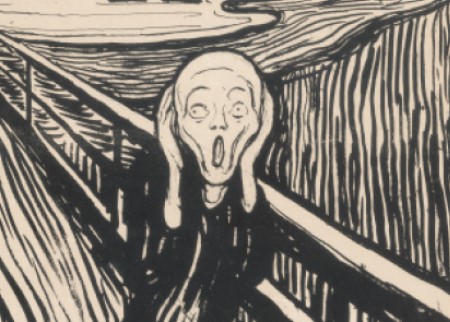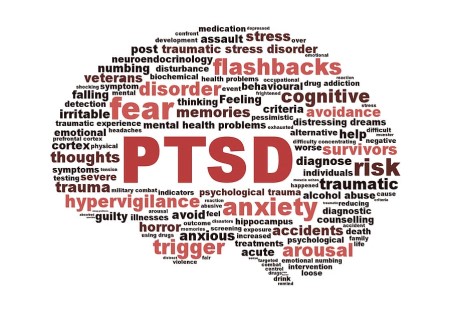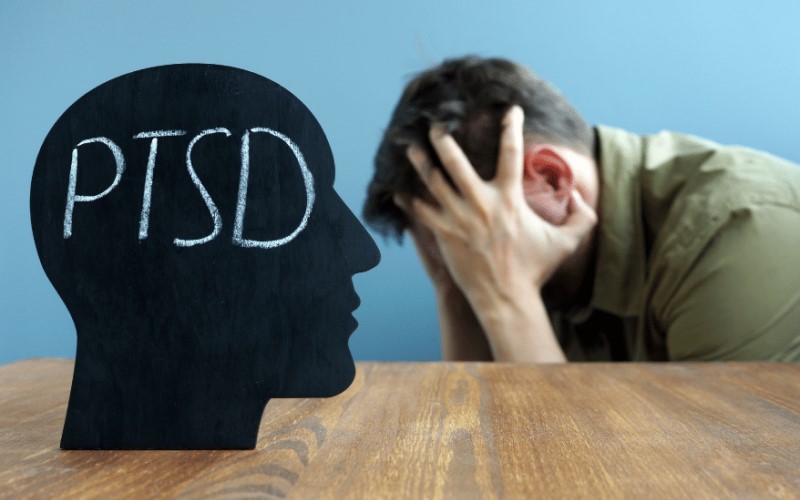The “Post-Traumatic Stress Disorder” (PTSD) is a mental health disorder, following a strong shock / a shocking episode / a moment of strong negative emotions (fear, pain), loss, fear, sadness, stress, anxiety).
This article attempts a brief reference on its identity, the way it is manifested and how any person could recognize the symptoms of this syndrome.
Post-Traumatic Stress Disorder (PTSD) – What it is, How & When it is developed – Reason for its occurrence

In most people’s minds, post-traumatic stress disorder (PTSD) has been associated with soldiers returning from the war zone alive at home.
Indeed, this is a typical example to understand how this disorder works (its causes and symptoms], however it is not the only one.
Every one of us – it is extremely possible – to have someone in its broader environment with this disorder, being a psychosomatic manifestation of fear, anxiety, intense terror, strong stress or shocking sadness, mental pain and loss.
Unfortunately, the Post Traumatic Stress Disorder (PTSD) is a psychosomatic reaction of the organism to extreme situations and shocking experiences, hardly diagnosed and dealt with. It is therefore necessary the support, help and guidance of its family.
A person’s exposure to extreme events of stress and terror, trauma and negative emotions (such as, a war situation, physical or sexual abuse, a sudden and unexpected loss of a loved person, a serious injury leading to permanent disability, an extreme natural disaster, a fight or an armed robbery) are very likely to cause emotional and psychological “wound” to the person.
This “wound” is finally embodied and expressed in terms of a physical pain, called Post Traumatic Stress Disorder (PTSD), a very serious mental health disorder, as it could lead to extreme behaviors (dangerous to person itself or those around it).
The most difficult question, however, is not “what is the “post-traumatic stress”, “how and when occurs”, but “why.
If we were looking for a way to explain why a person suffers from a post-traumatic stress disorder and another does not, we would say that it is clearly a “psychological issue” of each individual.
Just as a separation does not affect everyone in the same way (with others experiencing it is a more smooth way while others even manifesting depression / self-harm / suicidal tendencies), the same is true of any “trauma” experienced by any person (regardless of severity) .
A traumatic event involving the existence or threat of a physical death (in the literal or figurative sense) is likely to create a strong mental trauma, which can also be “expressed” by physical episodes.
Note: Referring to the “metaphorical” meaning of death, we mean the “termination” of a person or thing important in our life.
Therefore, even a natural disaster (and the material damage caused to personal belongings, combined with a strong sense of dread for survival), the removal of our dignity with a sexual abuse, domestic abuse or bullying, the loss of a limb (disability) or a very serious injury, a miscarriage or even a voluntary termination of pregnancy, even a terrorist act, robbery or other attack with the threat of a weapon, are also among the “deaths” but in a metaphorical sense of the word used.
Furthermore, we could mention that although to date there is no satisfactory medical explanation for the reason certain traumatic experiences are manifested in this way – it is an indisputable fact that:
- they have a serious effect on the thinking of the person involved
- they negatively affect its psychological and emotional state
- they determine its social behavior
- they make its daily life difficult
Post Traumatic Stress Disorder (PTSD) – Main Symptoms

A complex disorder such as the post-traumatic stress disorder (PTSD) is expected to manifest itself in many different degrees of severity, as well as in many different ways and symptoms.
Exposure to a traumatic event may cause a variety of reactions in the exposed person (reactions varying from person to person).
The first signs of PTS (Post-Traumatic Stress) are related mainly to the psychological externalization of the intense emotions experienced.
- sadness
- fear
- anger
- guilt
- terror
- rage
- constant annoying thoughts
- emotional “numbness” / apathy
- emotional discomfort
- aggression
- flashbacks to the past
- anxiety
These psychological “expressions” of the individual are in some cases an indication of PTS, requiring a psychological monitoring (preferably by a specialist).
These symptoms appear in the first few weeks after the traumatic event.
Over time – and if the condition is not treated – this person is very likely to manifest “physical expression” of its feelings.
- panic attacks
- intense palpitations
- sweating
- abdominal pain
- sleep disorders
- skin problems
- trembling
- chest pain (almost as a heart attack)
- back pain
- a strong feeling of nausea
- physical fatigue
- hysteria
- chronic pains
- hypochondria
- neurosis
- intense phobias
- sexual disorders
- gastrointestinal disorders
- autoimmune diseases
- total blindness
- deafness
- paralysis of the limbs (or severe weakness)
- manifestation of physical deformities
Just think of these, as some of the ways in which the body of the person experienced the trauma – will find to express the strong feelings of terror / agony / pain / anger that it caused.
The Importance of Dealing with the Situation (PTSD) Immediately

Have you ever felt the terror surrounding you?
Imagine this happening on a permanent basis, all day, on a 24 hours circle.
Fear is one of the most basic emotions of all humans, certainly including the man, caused by an existing or imaginary threat and a “mechanism” of the organism aiming at preventing it.
This reaction of the organism to the threats is not conscious, but involuntary and mechanical.
It is one of the seven (7) basic human emotions (along with anger, joy, sadness, disgust, interest and surprise), usually accompanied by other secondary emotions (such as stress, sadness, guilt and phobias).
Therefore, as the person faces an extreme situation – with the fear overwhelming it – many organs of the body are affected.
Fear not only relates to brain, but to many different organs and functions of the organism.
Below we examine the consequences of fear on the human organism in detail.
No.1: The Brain
The first transmission of “information” about a frightening event goes to (by stimuli through the various senses) the brain, and more specifically to brain amygdala.
This area of the brain – responsible for processing a person’s emotions – analyzes the data received and releases a chemical substance, called glutamate.
Glutamate will then act on the base and the gray matter of the brain, as well as on its hypothalamus.
In the first case, the fear can trigger physical reactions (such as shaking or freezing in the face of danger), while in the second case the signal passes to the CNS (Central Nervous System) and the Parasympathetic System.
This results in the secretion of adrenaline by the adrenal glands, which then goes through the bloodstream throughout the body causing an overstimulation and an energy burst.
No.2: The Respiratory System
As the fear increases, breathing becomes more difficult. Even if the fear is not real and in front of your eyes, it is possible to lead to a panic attack and intense difficulty in breathing.
Have you ever wondered why this happens?
However, even this seemingly “unconnected” reaction of the organism has a scientific explanation.
The nerves surrounding the lungs and the chest, due to the sudden threat and fear – intensify their function causing to the person a feeling of suffocation and pain in the chest area.
In any case, why are the lungs intensifying their function in the face of a threat?
It is an involuntary process of the body for survival. By receiving more oxygen to the lungs (and sending it to the brain) achieves faster and better thinking, helping the person to escape the threat confronted.
To achieve this, your body opens all the airways of the lungs wide, causing you this feeling of pressure (almost like a heart attack).
No.3: The Cardiovascular System
Clearly – even the cardiovascular system – is affected in the face of an impending danger, a fear, and a threat.
The heart rate rises dramatically, leading to a higher amount of blood flowing to all the muscles of the body.
This involuntary function of the body eventually gives the muscles the “food” needed to defend the life of the individual (by running to escape, by physical struggle, by repelling danger away).
No.4: The sweat
“He was bathed in cold sweat from his fear”. It is a very common expression and absolutely accurate and true.
Sweat is not an accidental reaction of the body to fear, being of great importance and scientifically explained.
By sweating, the body manages to keep the organism at a constant (low) temperature. This happening so the “enemy” – since man is also considered a hunting animal – cannot “smell” its fear.
This is because the sweat produced by the body due to fear and threat smells completely different (due to specific hormones produced by the organism) from sweat after intense training in the gym.
Therefore, the fact that you have a job interview and your palms are sweating, you know, is not a coincidence.
No.5: The Urinary System
Another expression derived from real experiences is “Peed from its fear”.
Also very accurate in what happens to the human body when confronted with fear.
Have you ever wondered what causes this intense need to urinate?
Extreme conditions of stress, terror and agony lead the body to lose the total control of the frontal lobe, resulting in loss of complete control of the bladder.
As a result, this is very likely in some cases, to lead even to involuntary urination.
No.6: The Ability to Concentrate
It is important – when faced with a threat – to be able to maintain your composure and concentration in order to avoid danger.
For this reason, nature, in the face of danger, strengthens our senses.
In fact, with the production of adrenaline in the body, the glucose and fat elements released into the blood channel energy to all the muscles of the body.
The purpose? To escape the danger.
So imagine again that the fear was not instantaneous, but permanent.
Never let your body relax.
This is the Post Traumatic Stress Disorder (PTSD), a permanent threat, a revival of the horror experienced by the person, a constant extreme mental and physical condition.
Conclusion

So normally – and following the end of the danger -, the Parasympathetic System of the organism protects the end of the feeling of fear possessed by the person, so can finally calm down and relax.
With this command, gradually, normality returns in all its basic functions.
The release of adrenaline stops, helping the heart to return to its normal and at the same time calms the entire body.
However, if the feeling of fear does not subside, the body continues to produce adrenaline and all the organs of the body function in complete stimulation, in the “red”, for maintaining the body alert to danger!
This entails enormous damage and exhaustion of the body, eventually leading to other dangerous situations.
Psychotherapy (with or without appropriate medication, a fact decided by the psychiatrist after a thorough examination of the person) is the most correct and effective method to deal with the trauma (and post-traumatic stress disorder – PTSD), preventing its chronic development or the “triggering” of other health problems.





